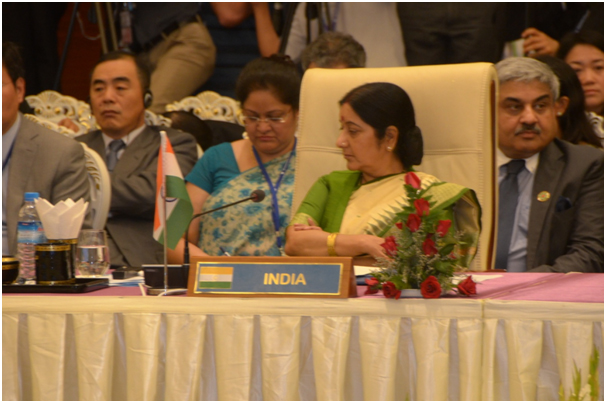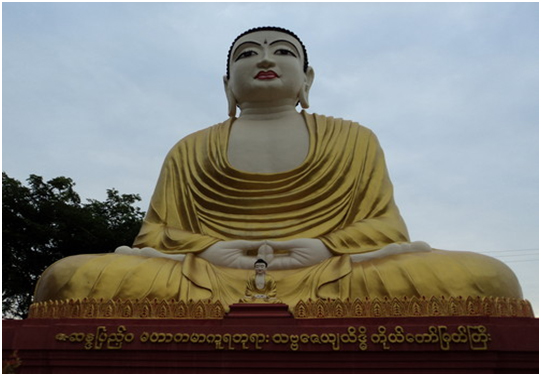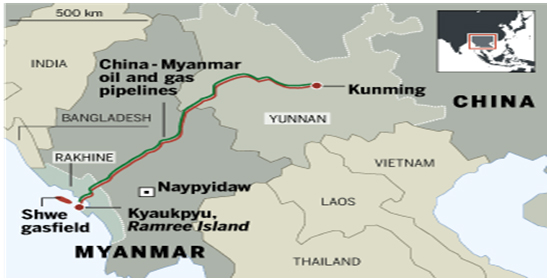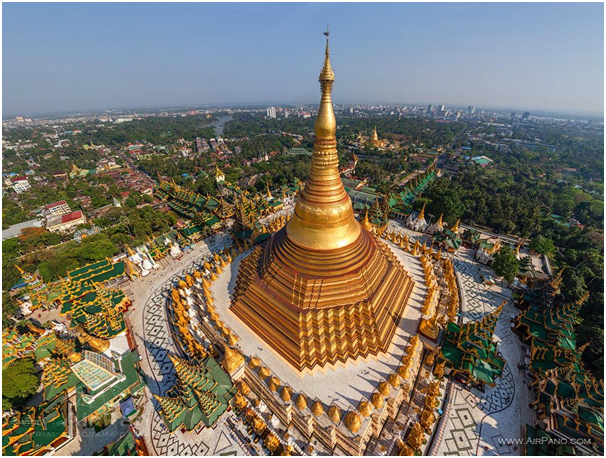India-Myanmar ties
12082014Buddha, Business and Bollywood
August 10, 2014,By Manish Chand,
Raising the bar for India-Myanmar ties (External Affairs Minister at 4th East Asia Summit Foreign Ministers’ Meeting in Nay Pyi Taw, Myanmar)
(External Affairs Minister at 4th East Asia Summit Foreign Ministers’ Meeting in Nay Pyi Taw, Myanmar)
 (External Affairs Minister at 4th East Asia Summit Foreign Ministers’ Meeting in Nay Pyi Taw, Myanmar)
(External Affairs Minister at 4th East Asia Summit Foreign Ministers’ Meeting in Nay Pyi Taw, Myanmar)
The “neighbours first” policy of the new government in India is again in focus with India’s External Affairs Minister Sushma Swaraj on her maiden visit to Myanmar August 8-11 for bilateral talks, as well as to attend ministerial meetings connected with ASEAN, East Asia Summit and ASEAN Regional Forum. Myanmar will be the first Southeast Asian country Sushma Swaraj will be visiting after trips to three important neighbours in South Asia: Bhutan, Bangladesh and Nepal. The minister’s visit will take place soon after Prime Minister Narendra Modi’s path-breaking trip to Nepal, and underlines the centrality of immediate and extended neighbourhood in India’s foreign policy matrix.
Why Myanmar matters: 5 Bs
 A bridge between South Asia and Southeast Asia, Myanmar has loomed large on India’s diplomatic horizon. Blending business, culture and diplomacy, there is a strong connect between the two countries. Buddhism, Business, Bollywood, Bharatnatyam and Burma teak — these are the five Bs that frame India-Myanmar relations in popular imagination. Moving beyond this rich configuration, the relations are now acquiring greater economic weight and strategic orientation.
A bridge between South Asia and Southeast Asia, Myanmar has loomed large on India’s diplomatic horizon. Blending business, culture and diplomacy, there is a strong connect between the two countries. Buddhism, Business, Bollywood, Bharatnatyam and Burma teak — these are the five Bs that frame India-Myanmar relations in popular imagination. Moving beyond this rich configuration, the relations are now acquiring greater economic weight and strategic orientation.
The minister’s visit to Myanmar comes days after the foreign office consultations between the two countries in New Delhi that saw the two sides discussing an entire gamut of bilateral issues, including trade and investment, energy and development cooperation. The talks in Nay Pi Taw, the new capital of Myanmar, will set the stage for Prime Minister Modi’s visit to the Southeast Asian country in November for the India-ASEAN summit and East Asia Summit.
The importance of Myanmar for India is all-too-obvious: India and Myanmar share a long land border of over 1600 km and a maritime boundary in the Bay of Bengal. Nurturing all-round relations with Myanmar is crucial to the economic transformation of India’s north-eastern states. Myanmar is also critical to India’s national security. The two countries have sealed a pact to share real time intelligence to combat Indian insurgents operating out of the border region. The pact envisages the conduct of coordinated patrols on each side of the border and maritime boundary and entails exchange of information to jointly combat insurgency, arms smuggling and drug, human and wildlife trafficking.
The bilateral relations, underpinned by the 1951 Treaty of Friendship, have stood the test of time and shown a rare dynamism and resilience. The visit of the then Prime Minister Rajiv Gandhi in 1987 laid the foundations for a robust relationship between India and Myanmar. The dawn of the third millennium has seen bilateral ties acquire a new force.
Two-way visits

The relations have experienced a visible upswing in the last four years since Myanmar’s embrace of political and economic reforms a few years ago. This was reflected in a spate of high-profile two-way visits: President U. Thein Sein came to India on October 12-15, 2011, the first state visit from Myanmar to India following the swearing-in of a new government in Myanmar in March 2011. This was followed by another transformational visit by India’s then Prime Minister Manmohan Singh to Myanmar from May 27-29, 2012, an important milestone that saw the two sides signing a dozen agreements and India extending a new line of credit (LOC) for US$500 million to Myanmar. President Thein Sein attended the India-ASEAN Commemorative Summit in December 2012 in Delhi and also visited Mumbai and Ratnagiri. Manmohan Singh visited Myanmar again for the BIMSTEC summit in March 2014.
Scaling up economic ties
Imparting a renewed momentum to economic relations will be a key focus area in the days to come. The energy-rich and resource-rich Myanmar has emerged as a land of opportunity, and with political and economic reforms it embarked on three years ago, the two countries look poised to galvanise its economic ties. Bilateral trade has gone up from barely 12 million dollars in the early 80s to nearly $2 billion.
A host of Indian companies have already pitched their tent in Myanmar and are thriving. These include, among others, the state-owned ONGC Videsh Limited (OVL), Jubilant Oil and Gas, Century Ply, Tata Motors, Essar Energy, RITES, Escorts, Ranbaxy, Cadila Healthcare Ltd, Dr. Reddy’s Lab., CIPLA, and Apollo. Top Indian companies are looking to invest $2.6 billion in a host of industries, including telecommunications, energy and aviation.
Energising Ties
 Energy cooperation is an important pillar of bilateral relations, with India’s state-owned and private companies acquiring gas blocs in that country. Seven Indian companies are among 59 companies shortlisted by the Myanmar government for submission of final bids for 18 onshore gas blocks on offer. OVL and GAIL have already announced $1.33 billion investment in China-Myanmar gas pipeline project.
Energy cooperation is an important pillar of bilateral relations, with India’s state-owned and private companies acquiring gas blocs in that country. Seven Indian companies are among 59 companies shortlisted by the Myanmar government for submission of final bids for 18 onshore gas blocks on offer. OVL and GAIL have already announced $1.33 billion investment in China-Myanmar gas pipeline project.
Food Security
Home to sprawling stretches of virgin forests and fertile land, Myanmar is emerging as a food granary of the region. Not surprisingly, India’s imports from Myanmar are dominated by beans, pulses and forest-based products. With its prowess in agricultural technologies, India has been all too willing to share its expertise to transform agricultural sector in Myanmar. In 2012, during then Prime Minister Manmohan Singh’s visit to Yangon, India pledged support for setting up an Advanced Centre for Agriculture Research and Education in Yezin and a Rice Bio-park in the integrated Demonstration Park in Nay Pyi Taw.
Development Cooperation
Capacity building and development cooperation are twin prongs of the growing India-Myanmar partnership. India has provided $500 million line of credit to Myanmar for a host of infrastructure and capacity building projects, the largest LOC to any Southeast Asian country. India has been in the forefront of empowering the people of Myanmar through training programmes like the ITEC and setting up centres of excellence in Myanmar like the Myanmar Institute of Information Technology (MIIT), which is being set up at Mandalay. (Industrial Training Centres, Myanmar-India Centre for English Language (MICELT), Myanmar-India Entrepreneurship Development Centre (MIEDC), India-Myanmar Centre for Enhancement of IT Skills (IMCEITS), Language Laboratories and E-Resource Centre at the Ministry of Foreign Affairs in Yangon and Nay Pyi Taw are some other outstanding projects that have been set up with India’s assistance).
Given Myanmar’s geostrategic location, India is focusing on accelerating connectivity projects like the Kaladan Multimodal Transit Transport Project and building/upgrading 71 bridges on the Tamu-Kalewa-Kalemyo road. The trilateral highway that will provide seamless connectivity between India, Myanmar and Thailand by 2016 is poised to be a game-changer.
Democracy Connect
Myanmar’s ongoing journey towards democratic transformation promises to bring India and Myanmar closer as the Southeast Asian country taps India’s expertise in institution-building. In the past few years, scores of parliamentarians from Myanmar have been coming to India for training in parliamentary practices and procedures.
People Power
 (Shwedagon Pagoda, Yangon, Myanmar)While diplomacy and business have their own logic, it’s people-to-people relations that impart a special character to the enduring friendship between India and Myanmar. Myanmar is home to 2.5 million-strong Indian diaspora, settled mostly in Yangon and Mandalay. Iconic Myanmar leader Aung San Suu Kyi has a special connection with India. She studied in Delhi’s Lady Shriram College when her mother was posted as ambassador in India. Boddh Gaya, the birthplace of Lord Buddha, is a must-visit place for Myanmar’s leaders and pilgrims. The Sarnath-style Buddha statue donated by the Indian government to people of Myanmar and installed at the Shwedagon Pagoda premises remains a shining symbol of cultural and civilizational connect between the two countries. Straddling the classical and the modern, Bollywood and Bharatnatyam are equally popular in Myanmar. And yoga is acquiring new devotees among the young and the old in the neighbouring country.
(Shwedagon Pagoda, Yangon, Myanmar)While diplomacy and business have their own logic, it’s people-to-people relations that impart a special character to the enduring friendship between India and Myanmar. Myanmar is home to 2.5 million-strong Indian diaspora, settled mostly in Yangon and Mandalay. Iconic Myanmar leader Aung San Suu Kyi has a special connection with India. She studied in Delhi’s Lady Shriram College when her mother was posted as ambassador in India. Boddh Gaya, the birthplace of Lord Buddha, is a must-visit place for Myanmar’s leaders and pilgrims. The Sarnath-style Buddha statue donated by the Indian government to people of Myanmar and installed at the Shwedagon Pagoda premises remains a shining symbol of cultural and civilizational connect between the two countries. Straddling the classical and the modern, Bollywood and Bharatnatyam are equally popular in Myanmar. And yoga is acquiring new devotees among the young and the old in the neighbouring country.
Seize the Day
Myanmar’s opening-up in recent years has made the country an arena of competition among established and new players. The democratisation, along with economic reforms, has unleashed new opportunities for India, which is determined to make up for lost time. With a creative blend of diplomacy, diplomacy and culture, the India-Myanmar relations can only scale new heights in days to come.
(Manish Chand is Editor-in-Chief of India Writes Network,www.indiawrites.org, a portal and e-journal focused on international affairs and the India Story)
No comments:
Post a Comment